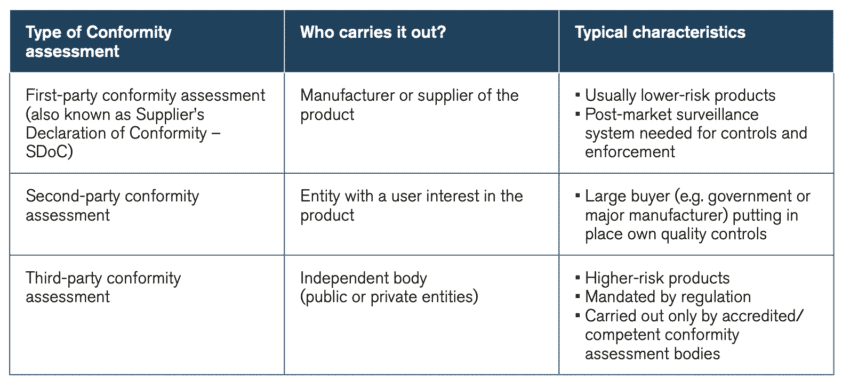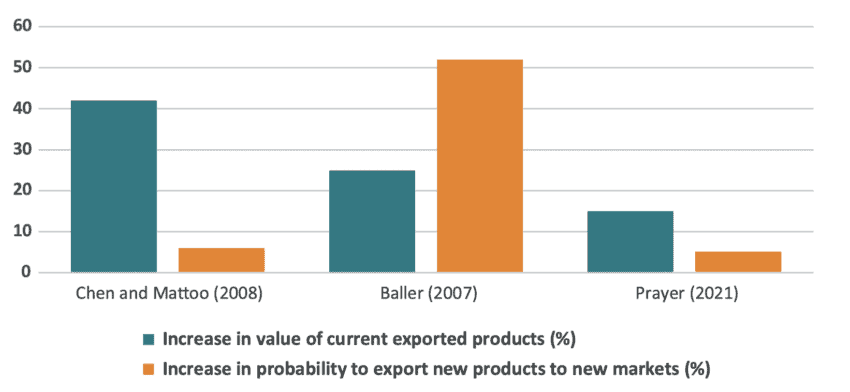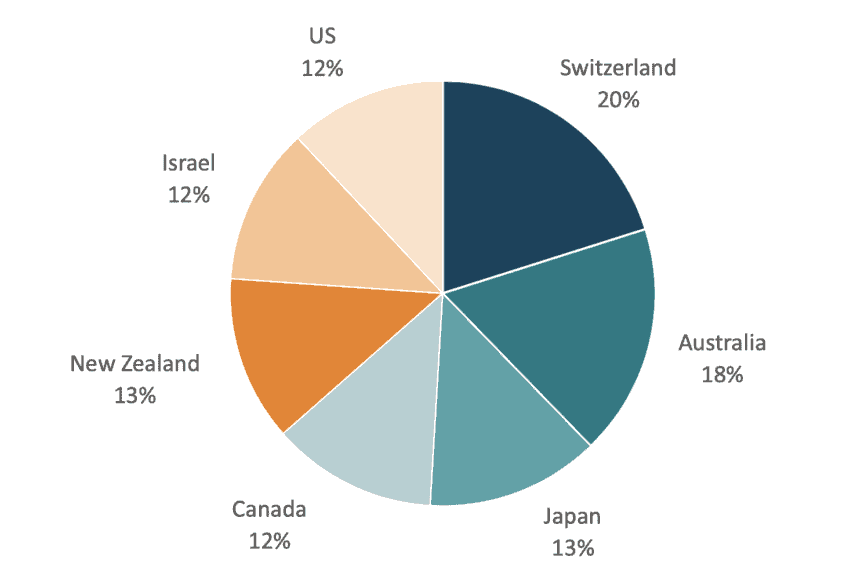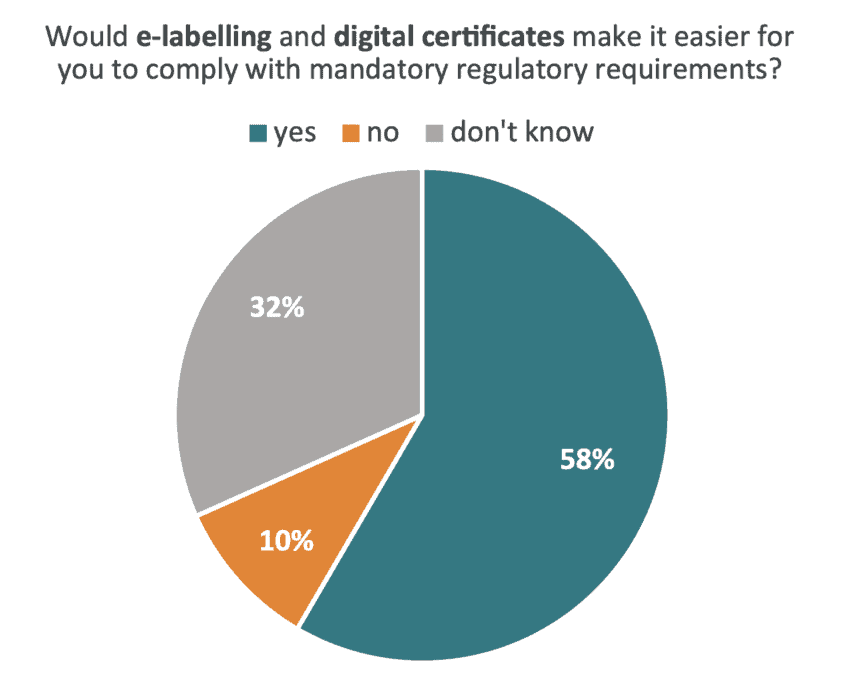How Important are Mutual Recognition Agreements for Trade Facilitation?
Published By: Lucian Cernat
Subjects: EU Trade Agreements
Summary
Trade in the 21st century may face lower tariffs, but regulations that affect international trade in goods and services have proliferated. While regulations are important for many public policy objectives, different and complex non-tariff measures can become unnecessarily costly trade barriers for the millions of companies engaged in international trade. Trade policy can play a crucial role in reducing these unnecessary costs, without impairing the ability of regulatory authorities to carry out their public policy responsibilities. Mutual recognition agreements (MRAs) are a concrete trade policy instrument, specifically designed to achieve this dual objective. This paper revisits the arguments in favour of upgrading the existing EU MRAs to cover 21st century regulatory aspects impacting trade flows, offering empirical evidence on the positive difference MRAs have both on the value of exports and on increasing the number of exporting firms and their product portfolio towards new export destinations. The paper also summarises the results of a recent EU firm-level survey on the importance of MRAs for export performance. The results of the EU business surveys confirm the need for a renewed attention to MRAs, in particular with regard to emerging regulatory issues.
The views expressed herein are those of the author and do not necessarily reflect the views of the European Commission. The author would like to thank Katja Modric-Skrabalo and Oscar Guinea for the significant contributions to this paper and to Georgios Papatzikas for his research assistance. Special thanks also to the TBT team in DG TRADE for their useful comments and feedback.
1. The importance of regulatory cooperation for trade facilitation
International trade is present in everyone’s life. Our daily routine depends on complex trade flows and production processes scattered across multiple countries, even if this hardly gets noticed by the final consumers. Trade flows have evolved over time and are becoming increasingly intricate, with countless parts and components crossing multiple borders at different stages of production along global supply chains before reaching the final consumer. While trade flows today may face lower tariffs, non-tariff rules and regulations that affect international trade in goods and services have proliferated. These non-tariff measures (NTMs) can play an important role in addressing public policy objectives, such as consumer safety or environmental protection. Companies and products engaged in complex global supply chains need to comply with a whole range of administrative and technical requirements, including testing and certification obligations that may differ from one country to another. At times, such different and complex non-tariff measures can become unnecessarily costly trade barriers for the millions of companies engaged in international trade.
These unnecessary regulatory costs matter both for exporters and end consumers. EU exporters offered clear examples of such barriers, as part of a pan-European business survey (European Commission and UNITC, 2016). For instance, an Italian company exporting lamps and lighting indicated that they need a certificate of conformity for their products that can only be issued from a third country, leading to additional shipping and testing costs, plus delays of several weeks before being able to export their products. A Greek exporter of frozen yoghourt indicated that, for certain destinations, their products must obtain a halal certificate. Due to the lack of an accredited certifying authority in Greece, the producer has to use the services of an accredited body abroad, leading to additional costs of €60,000 per year. Quite often, producers are required to obtain certification by a specific accredited entity in the importing country. To complete the certification, producers and exporters are required to ship samples of their products for inspection and hire local intermediaries to facilitate the certification process. A Lithuanian exporter of metallic products estimated that the costs associated with such procedures can be up to 33% of the value of the exported product.
The difficulties faced by EU exporters abroad are related to the different conformity assessment procedures applicable to products, across different jurisdictions. According to the International Standards Organisation (ISO), conformity assessment is described as “different techniques that ensure a product, process, service, management system, person or organisation fulfils specified requirements”.[1] Table 1 summarises the main types of conformity assessment procedures and their key characteristics.
Table 1: Main types of conformity assessment procedures Source: Author’s elaboration based on ISO/IEC 17000.
Source: Author’s elaboration based on ISO/IEC 17000.
One may think that this anecdotal evidence indicates only isolated incidents of burdensome procedures encountered by a handful of companies. However, these examples were collected as part of a comprehensive, detailed questionnaire on a statistically relevant sample of over 8’000 EU exporters (European Commission and UNITC, 2016). Problems linked to product certification accounted for the largest share of all the non-tariff measures recorded during the survey. The EU exporters participating in this survey identified over 2,300 problematic issues related to conformity assessment for their exported products. Interestingly, more than 90% of these certification issues were (partially or entirely) deemed problematic because of procedural obstacles rather than the ability to comply with the technical norms and standards in the importing country. This is an important point since one instrument available in our trade policy toolbox (mutual recognition agreements) is specifically designed to address such procedural trade obstacles.
[1] See ISO website. Conformity Assessment. Techniques and Schemes. Retrieved from https://www.iso.org/sites/cascoregulators/01_1_conformity-assessment-techniques.html. See also ISO/IEC 17000.
2. Mutual recognition agreements: A neglected policy tool?
Trade policy can play a crucial role in reducing these unnecessary product certification costs, without impairing the ability of regulatory authorities to carry out their public policy responsibilities. While free trade agreements have been considered in recent years, alongside WTO rules, as the main vehicle to reduce such unnecessary trade costs linked to testing and conformity assessment procedures, they are not the only available tool for trade policy makers. One regulatory cooperation instrument used to reduce unnecessary trade costs for companies engaged in global supply chains is the so-called mutual recognition agreements (MRAs). Unlike FTAs, MRAs are relatively unknown, beyond the trade and technical experts that are involved in such specialised work. Although less known, MRAs have been used to facilitate trade among many countries, as evidenced by the comprehensive survey carried out by Correira de Brito, Kaufmann and Pelkmans (2016). Four distinct types of MRAs can be distinguished (Table 2).
Table 2: A Taxonomy of MRAs Source: Own elaboration.
Source: Own elaboration.
Typically, MRAs acknowledge a body in another country as competent to evaluate compliance with relevant domestic legislation (European Commission, 2022b). As a result of their specific features, MRAs can facilitate trade and deliver benefits for companies when the products they export are subject to mandatory third-party conformity assessment in the destination market. In essence, they allow the exporting jurisdiction to designate its own eligible conformity assessment bodies (CABs) as capable of testing and certifying exported products against the regulatory requirements applied by the importing market. MRAs allow exporters to reduce the certification costs by using the same local facilities for testing their products that are sold domestically or exported, as long as the local laboratory is accredited under the MRA.
MRAs also reduce the time and shipping costs related to testing and conformity assessment of products to and from third country laboratories. With an MRA in place, EU exporters save time and money for the testing and certification process by relying on the CABs in their domestic markets when exporting abroad. It is also important to highlight that the underlying principle for any MRA should be mutual trust by the signatories in each other’s conformity assessment systems. In particular, the capacity to monitor and guarantee their competence to test and certify products for compliance with prevalent local regulatory requirement in different export destinations.
The EU has a number of such MRAs dating back to the late 1990s, mostly with developed countries (Australia, Canada, Japan, New Zealand, the USA, Israel and Switzerland). These MRAs vary somewhat in terms of their sectoral scope (e.g. telecoms, maritime equipment, medical devices, automotive, machinery, pressure equipment, toys, construction equipment, electrical products, etc.) as well as in terms of their design.
3. Why are MRAs more important that you think?
Mutual recognition agreements provide a useful approach to address a number of market failures and regulatory frictions. Typically, CABs tend to specialise in assessing conformity with specific types of regulations prevalent in individual markets. Hence, most CABs are usually recognised by single countries. A company exporting products to multiple markets may be forced to undergo third-party conformity assessment repeatedly and with different CABs to demonstrate compliance with conformity requirements in different export markets.
Traditional, non-harmonised MRAs strike a balance between regulatory autonomy (each party retains its regulatory requirements, no harmonisation or mutual recognition thereof required) while reducing the compliance costs, allowing EU exporters to use the same CABs for domestic markets, intra- and extra-EU exports. According to the existing empirical evidence, several factors are at play that make MRAs economically meaningful:
- MRAs reduce the total, fixed-cost of conformity procedures by allowing firms to use the same CABs for multiple destinations;
- MRAs also reduce the marginal costs (cost per product) of conformity assessment, since different firms sell different product varieties to different markets. Having one testing lab checking the entire portfolio of products reduces the conformity assessment cost for each product category. This has also a positive impact on the likelihood of small firms to expand their exports into new markets, where so far they were not present;
- MRAs increase the competition in the conformity assessment sector, allowing exporters (especially SMEs) to choose from a wider range of CABs, thus reduce the overall cost of such procedures;
- MRAs can facilitate the diversification of global supply chains as a result of a wider choice of critical suppliers, if more firms/markets are covered by MRAs.
The existing economic literature confirms the existence of all these economic benefits and offers robust estimates of the order of magnitude for trade gains stemming from MRAs (Figure 1). Several empirical econometric estimates indicate that existence of an MRA makes a positive difference both on the value of exports (15-40% increase) and on the probability of firms to export (new) products to (new) markets (up to 50% increase in the probability to export).
Figure 1: The economic impact of MRAs on trade flows Source: Author’s compilation, based on Chen and Mattoo (2008), Baller (2007) and Prayer (2021).
Source: Author’s compilation, based on Chen and Mattoo (2008), Baller (2007) and Prayer (2021).
While MRAs have a more limited scope than FTAs in terms of product coverage, they do have a considerable impact on trade flows, primarily since the cost and delay of conformity assessment is one of the most problematic non-tariff barrier (NTB) faced by exporters (European Commission and UNITC, 2016). As a result of this high level of initial NTBs, for the products covered by these MRAs, the trade benefits generated by MRAs are quite considerable for the sectors concerned. The fact that such MRAs are useful and effectively implemented is also demonstrated by the large number of CABs that have taken the additional efforts to be designated and operate under these MRAs (Figure 2).
Figure 2: EU conformity assessment bodies accredited under various EU MRAs Source: Based on the EU NANDO database, European Commission (2022a).
Source: Based on the EU NANDO database, European Commission (2022a).
Given the strong dependence of EU exports on the sectors covered by MRAs and the high cumulative share of our partners in total EU trade (around 30% of total EU exports), it would be important to ensure that MRAs continue to play a prominent role in our future trade policy toolbox. The MRAs are also very valuable for our trading partners. Over 80 foreign CABs are also currently using the EU MRAs to certify industrial products that are exported from MRA signatory countries to the EU market.
4. Is there scope for new or enhanced MRAs? The view from EU exporters
The existing MRAs cover core sectors that are crucial for EU global export competitiveness. However, given the fact that such MRAs were concluded more than 20 years ago, the scope of such MRAs does not include the 21st century issues for which new regulatory requirements are now being developed. Currently, the EU regulatory agenda covers many aspects linked to the twin digital and green transition. A range of new or upcoming EU regulatory and conformity assessment requirements will cover issues related to eco-design, energy consumption and CO2 emissions. Many industrial and consumer products are “smart devices” with digital features that require cyber-certification. Few of these new regulatory requirements are covered by existing MRAs. Since these issues are of common global concern, there might be potential for closer regulatory cooperation in such areas with interested partners. The existing evidence indicates that MRAs have generated tangible export gains and are very valuable for key industries, in conjunction with FTAs or in the absence thereof. Compared to FTAs, MRAs require fewer resources to negotiate and implement their provisions.
To test the interest of EU exporters in MRAs, the European Commission ran an online survey in 2022. The survey was targeted at EU companies manufacturing or selling industrial products abroad. Its aim was to increase awareness among EU industries of the opportunities provided by MRAs and to identify specific priorities for EU exporters with regard to conformity assessment in markets outside the EU. The survey received over 200 replies, most of them from individual exporting companies and only a handful of answers from sectoral or business associations. The majority of the survey participants (54%) were small and medium sized companies, while the rest of respondents were large firms or business associations.
About one third of respondents indicated that they use at least one of the existing MRAs, with the rest of respondents indicating that they do not use MRAs (for a variety of reasons, e.g. since their products and export destinations are not covered by existing MRAs), or are simply unaware of the actual use of such MRAs. The relatively high share of “don’t know” answers in the 2022 MRA survey also revealed that, while the existing MRAs are useful, their potential is not well-known by EU exporters and thus greater awareness raising would lead to greater trade benefits.
While these results may be interpreted as an indication of low utilisation rate for the existing MRAs, this could be misleading. When looking at the cumulative share of MRA partners in total EU exports, this amounts to somewhat less than one third of EU exports. Since MRAs cover only a few EU trade partners (e.g. Australia, Canada, Japan, New Zealand, Switzerland, the United States) and have a limited sectoral coverage (e.g. machinery, telecommunication equipment, medical devices), EU exporters that do not export such covered products to MRA signatories cannot use any existing MRAs. Essentially, the ratio of those companies using the existing MRAs is proportional to the share of trade covered by these MRAs. Against this background, the rate of use for the existing MRAs looks in line with their trade coverage.
In terms of geographical scope, the survey participants indicated a fairly evenly distributed use of the existing MRAs, with the EU-Swiss MRA standing out as the most used one (Figure 3). This is consistent with expectations, given the geographical proximity and the broader scope of this MRA both in terms of product coverage as well as its level of ambition in reducing the regulatory red tape on conformity assessment procedures achieved by the EU-Swiss MRA. One interesting finding is that existing MRAs with smaller trading partners by trade values (e.g. Australia, New Zealand, Canada) seem to have a similar use rate for survey respondents, compared to bigger trading partners such as the United States or Japan.
Figure 3: Which MRAs are the most used by EU exporters? (Percentage of total respondents) Source: Author’s elaboration based on the survey results.
Source: Author’s elaboration based on the survey results.
This seems to indicate that the value of an MRA does not depend on market size. One possible explanation is precisely the fact that if certification requirements are a fixed cost, they represent proportionately higher ad-valorem trade barriers for smaller export destination with lower trade values. Following a similar logic, the fixed costs of product testing and certification is proportionally higher for SMEs and companies that have typically much lower exports values than larger firms. According to Eurostat Trade by Enterprise characteristics data, the average export value in 2020 for an EU exporting SME was below 1 million euros, whereas the average export value for larger firms was over 25 million euros. Thus, for the same fixed-cost of testing procedures and conformity assessment, the trade cost for SMEs can be several times higher. Consequently, MRAs provide exporting SMEs with a valuable cost-reduction option.
This leads us to a simple but powerful first conclusion: trade policy is not firm-size neutral, and the current prevalence of non-tariff barriers makes it more difficult for SMEs to engage in international trade (Cernat, 2021). Under these circumstances, the existence of an MRA would confer greater benefits for companies and destinations where the lower export values would render certification activities disproportionately costly, since the fixed costs will be spread on a lower value of exports and hence become a higher trade impediment.
The 2022 survey also contained questions about the importance of digitalisation efforts in the area of certification and conformity assessment. The majority of survey participants (58%) consider e-labelling and digital certificates as having a positive contribution in facilitating compliance with mandatory requirements (Figure 4).
Figure 4: The trade facilitation potential of digital certificates and e-labelling Source: Author’s elaboration based on the survey results.
Source: Author’s elaboration based on the survey results.
The survey also included a number of questions about the rationale of using an MRA and the source of the trade facilitation benefits conferred to such agreements. The overwhelming factor for 80% of respondents that use the existing EU MRAs was the cost-saving potential. Respondents also consider MRAs valuable for several other reasons (e.g. higher trust in the EU certification system). Looking into the future, 73% of respondents that have used existing MRAs stated that they would have an interest in using new MRAs or in expanding the scope of existing MRAs to new sectors in order to address in particular barriers related to testing and certification in key EU exporting sectors, such as construction products and cosmetics.
The potential benefits offered by MRAs are not only relevant for EU exporters but also for other trading partners. The results of a 2006 survey carried out by the OECD secretariat across its Members found that MRAs were one of the most important trade facilitation instruments (Fliess and Schonfeld, 2006). The OECD survey also confirmed the difficulties faced by exporters in dealing with conformity assessment procedures, either due to lack of information, the repetition of identical testing requirements in home and destination countries, or lack of acceptance of home-country test reports.
5. Conclusions
This paper highlighted the importance of regulatory cooperation as an avenue for tackling non-tariff barriers and focussed on the untapped potential of mutual recognition agreements (MRAs), an instrument in the EU trade policy toolbox that received little attention in the last couple of decades. Procedural obstacles linked to certification procedures, such as the ones tackled by MRAs, are some of the most prevalent and costly trade barriers affecting EU companies engaged in global supply chains and their customers worldwide. The two EU business surveys that have been conducted on the role of NTBs and MRAs in 2016 and in 2022 provide robust empirical evidence that EU exporters are facing considerable NTBs abroad and are interested in MRAs as an effective trade facilitation instrument. The results of the EU business surveys also indicate the need for a renewed attention to MRAs, in particular with regard to the 21st century emerging regulatory issues (e.g. sustainability, climate change, digital transformation) that are poised to significantly affect the ability of EU exporters to rely on trade as a driver of competitiveness and prosperity in Europe.
References
Baller, S. (2007). Trade effects of regional standards liberalisation: a heterogeneous firms approach. World Bank.
Chen, M. X. and Mattoo, A. (2008). Regionalism in standards: good or bad for trade? Canadian Journal of Economics 41 (3).
Cernat, L. and Boucher, D. (2021). Multilateral cooperation behind the trade war headlines: How much trade is freed up? CEPS Policy Insights No. PI2021-03/ February 2021.
Cernat, L. (2021). From SMEs to Unicorns: What Role for Trade, Standards and New Tech? ECIPE Policy Brief No. 13/2021.
Correia de Brito, A., C. Kauffmann and J. Pelkmans (2016). The contribution of mutual recognition to international regulatory co-operation. OECD Regulatory Policy Working Papers, No. 2, OECD Publishing, Paris.
European Commission (2022a). The New Approach Notified and Designated Organisations Information System (NANDO Database). Retrieved from https://ec.europa.eu/growth/tools-databases/nando/index.cfm?fuseaction=mra.main
European Commission (2022b). Blue Guide on the implementation of the product rules 2022, Directorate-General for Internal Market, Industry, Entrepreneurship and SMEs, 29 June 2022.
European Commission (2021). EU survey on testing and certification barriers in EU export market. Retrieved from https://www.brusselsnetwork.be/fr/survey-on-testing-and-certification-barriers-in-eu-export-markets/
European Commission and UNITC (2016). Navigating non-tariff measures: insights for a business survey in the European Union, Brussels and Geneva. Retrieved from https://trade.ec.europa.eu/doclib/docs/2016/december/tradoc_155181.pdf
Fliess, B. and R. Schonfeld (2006). Trends in Conformity Assessment Practices and Barriers to Trade: Final Report on Survey of Cabs and Exporters. OECD Trade Policy Papers, No. 37, Paris.
International Organisation for Standardization (ISO) (2020) Conformity assessment — Vocabulary and general principles, ISO/IEC 17000:2020.
Prayer, T. (2021). The effect of MRAs on firm-product-level international trade. ITFA working paper.